
Property History
How to research the history of your home
Materials held at the La Crosse Public Library Archives & Local History Deptartment are uniquely capable of aiding patrons to research the history of properties in La Crosse. In the Archives, this research is called a "property history." Typically, the Archives staff members conduct this research for patrons by using:
- County Parcel Search Database
- Maps
- City Directories
- LPL's Obituary Index
- Local Newspapers
- City Tax Records
- Photographs
Some of these resources are available online for you to complete your own research. Below is a guide for accessing and using these digital resources, so that you can learn how to research your home or property yourself.
To help guide you through some of these digital resources and how they work, we will use the example of 236-240 9th St. S. in La Crosse, WI.
County Parcel Search
Because house numbers may have changed throughout the city’s history, addresses aren’t considered a permanent (i.e. stable) indicator of a building’s identity. This is why when studying the history of a property, we look at the house or building's legal description. The easiest way to find the legal description of a local house or building is by searching the La Crosse County Parcel database.
When you find the appropriate house or building that you are searching for, you will see a long, complicated series of words and numbers that may seem like they do not mean anything. This is the legal description.
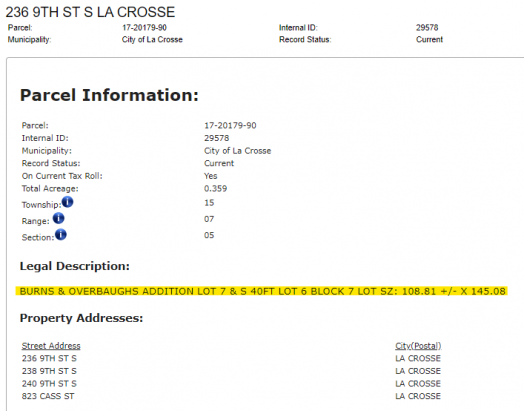
It’s easier to read this if you split it into four sections:
Burns & Overbaughs Addition = the name of the addition or plat
Block 7 = the block number within the plat
Lot 7 & S 40ft [of] Lot 6 = the lot numbers within the block that the property covers
Lot [size] 108.81 x 145.08 = The exact dimensions of the lot; this piece of information isn’t typically needed in researching the history of the property, though it can be nice for reference if the property has changed.
If this doesn't make sense to you, it will help to look at a map!
Maps
Though there are hundreds of digitized maps available, we are only going to focus on two maps. These maps are our favorites to use because they give indicators to the structure's building materials, size, and shape, which can help us if there is any question of a property being remodeled or moved through its life.
1898 City Atlas
The 1898 City Atlas is available online here. First, click on the link that will bring you to the Table of Contents on page 3. If you cannot read the image, you will want to go to the four white, unlabelled rectangles on the left hand menu. Use these rectangles to change the size of the image. It may still be blurry, but should become large enough on your screen to read the text on the image. You can also click on “Image Detail” in the left hand menu to get a more interactive image that you can zoom in on even further.
The Table of Contents is indexed by plat names, which is where the legal description comes in.
Let’s use the example from the Parcel Search section above: 236 9th St. S. The legal description says it is in the Burns & Overbaughs Addition–this is the plat name. In the Table of Contents for the Atlas, we can see that “Burns & Overbaughs Addition” is on page 17. Scrolling up on the page, you can enter “17” in the “Go to page” box:
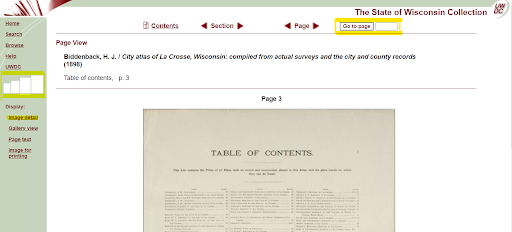
On page 17, we see 9th St. intersect with Cass St., where we know the house is located. And we see “Burns & Overbaughs Add” labelled in a yellow background color, as well as block and lot numbers to identify properties. We can see that all the information lines up between the address and the legal description of the property listed under 236-240 9th St. S. Even the shape of the house is detailed enough that it helps us identify it:
Page 17, 1898 City Atlas
1906 Sanborn Map
The Wisconsin Historical Society has a number Sanborn Fire Insurance maps of La Crosse digitized. They can be accessed here. These maps were created with great detail so insurance companies would know how much to insure structures for. This means they show the composition and footprint of the structures, as well as other fire risks, like each and every lumber pile held at the sawmills. It also labeled where fire hydrants and alarms were throughout neighborhoods. Today, they are incredibly helpful for understanding our historic built environment.
Unless the building or home you are researching is in the downtown area, it likely will not show up until the 1906 Sanborn map. If you know for certain that the structure you are researching was built early enough and central to downtown, it's worth looking through the older maps.
The indexes for the Sanborn maps are listed by address. There is also a map index (Sheet 0) that tells you which page blocks are on. These maps are digitized at a high resolution, so as you zoom in on them, the details get very clear and are easy to read, even the small text.
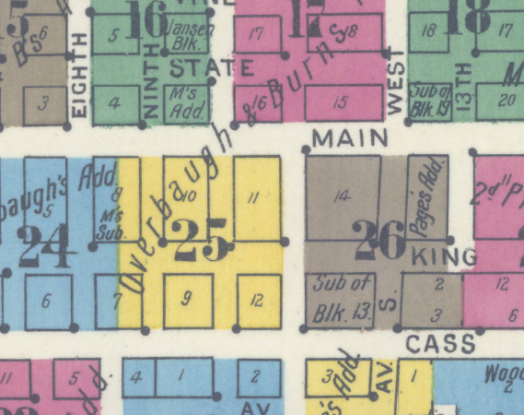
1906 Sanborn Map, sheet 0
In the above image, we can see that 236-240 9th St. S. is on Sheet 25. You’ll notice the legal description information is labelled on this map as well.
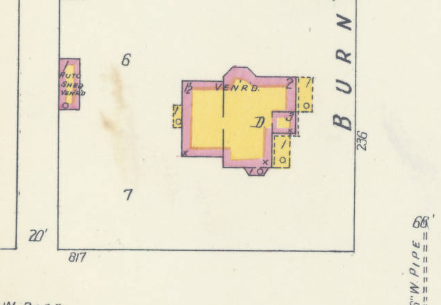
1906 Sanborn Map, sheet 25
When we go to sheet 25, we can look at the house and find many details. On the street, you can see the label “236,” which means this house held one of the same addresses in 1906 that it does today. The colors mean that it is brick veneered (pink) with a frame structure (yellow). The circles are the kinds of pipes in the house. Even the shed in the backyard has this kind of detail. The alley is 20 feet wide, and it looks like there is a 68-foot pipe under the road. The "6" and the "7" are the lot numbers, which aligns exactly with the legal description, as we've already confirmed.
City Directories
City Directories are often compared to phone books today because they had a similar function: allowing community members to find and get in touch with one another. Although they were organized similarly, they provided different information than we might think of being available in a phone book. Early City Directories only listed the head of a household, their address, and occupation, sometimes with the added bonus of their place of employment. Later directories listed all adult household members as well as phone numbers in addition to that original information.
La Crosse City Directories have been digitized and are searchable online for the years 1866-1966. The reason they stop being available after the year 1966 is because of copyright laws. In the Archives, we hold the City Directories in bound versions from 1866-2020.
The 1866-1966 City Directories are available here. Until you get the hang of how addresses are written inside the directories, we recommend you simply browse through the directories to find your address instead of using the search function (because it will only search exact phrases). Note that before 1907, the directories were only organized by last name. After 1907, they had one section organized by last name and another section organized by address. You’ll also notice that it is rare for women to be listed in the older directories.
I found 236 9th St. S. on page 143 of the 1907 City Directory, Louisa was the widow of Niram Withee, which is why her name is listed and not his.

1907 La Crosse City Directory, page 143
You can learn more about how to use City Directories to research a neighborhood's cultural and social history by reading this piece here, published as a La Crosse History Club activity (a program managed by the Archives Department staff).
If you would like to look through multiple years and want to make notes, feel free to use this worksheet that we use in the Archives when completing house histories. You can download and print this PDF:
Obituary Index
As you begin finding names of historic people who lived in or occupied the structure you are researching, you may get curious about their lives. The best way to find more information about them and their family is by reading their obituary, which often gives vibrant information. Once you have a name of someone that you would like to learn more about, you can search that name in our Genealogy Database, which will give you a citation for someone’s obituary if they died in the area.
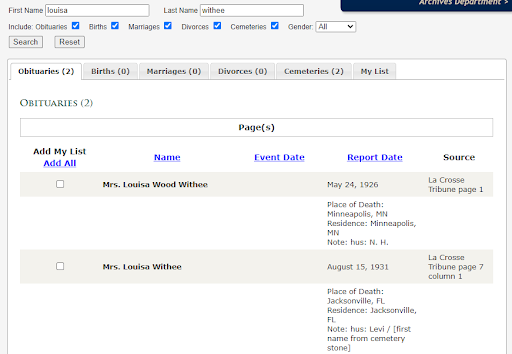
If the obituary/ies that you find were published between 1904 and 1977, then you can find them online through one of the newspaper databases paid for by the La Crosse Public Library. You can find directions for that below.
As you can see in this example here, there just happened to be two Louisa Withees. In the notes, it lists who each woman's husband was. We know that the Louisa who lived at 236 9th St. S. was married to Niram Withee, so we can take the educated guess that the Louisa who died in 1926 is our gal.
Historic Newspapers
To access the two newspaper databases available through the library, you need to use the portals on the Archives’ website. If you are a La Crosse resident and have an LPL library card, you will be able to use NewspaperArchive. If you are a Wisconsin resident, you can access Newspapers.com even without a library card. If you are neither of these kinds of residents, visit the website of your local library (and if you are a student, check your university library website) to see if they pay for either of these databases. If they do, you can still access the La Crosse Tribune.
We will use NewspaperArchive in our example. If you would like guidance using Newspapers.com, please contact Archives staff.
One tip we have is to narrow your search to La Crosse, and if you still have a lot of results, narrow it even further to the decade or year of the citation you found in the database. If you don’t get any results, then try browsing by date and finding the obituary without searching the person’s name. Sometimes the search function cannot read the text in the image and won’t find the article. But that doesn’t mean it isn’t there! You just have to be patient.
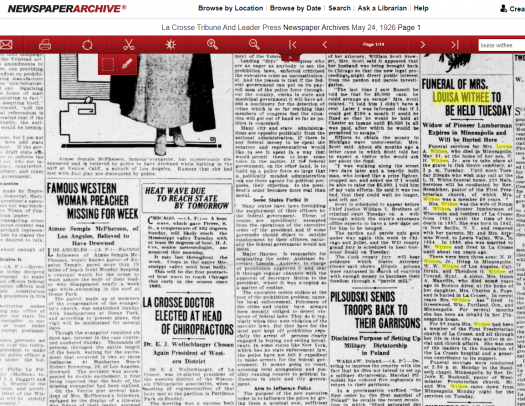
Louisa Withee's obituary and funeral notice, printed in the May 24, 1926 newspaper on the front page.
Other Resources Available Only in the Archives
At this time, the above resources are the only records available online that can pertain to the property/ies you would like to research. Most people want to know the exact year that a structure was built, which we can typically only verify or find by using the City Tax Records, which are available only at the Archives. If you would like to learn this piece, contact the Archives.
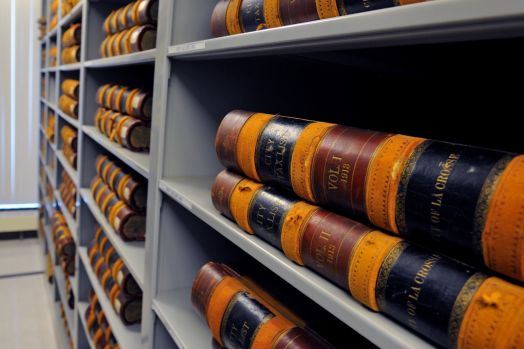
Tax Records books in Archives climate-controlled vault room
We also always look at our photograph collection, to see if we can find a street scene or portrait of a house. It isn’t incredibly common that we do, but if the house or building is on a prevalent street, then it’s possible.

An illustration of 238 9th St. S. from the 1881 book History of La Crosse Wisconsin, page 685
How to donate materials about your home to the Archives
Some people find papers, photographs, blueprints, and more in their home when they move in. If you happen to have documents relating to the history of your house, the Archives would love to have them to make them accessible for the public and gather a more accurate narrative of our local history. Contact the Archives if you’re interested in talking about this process.

